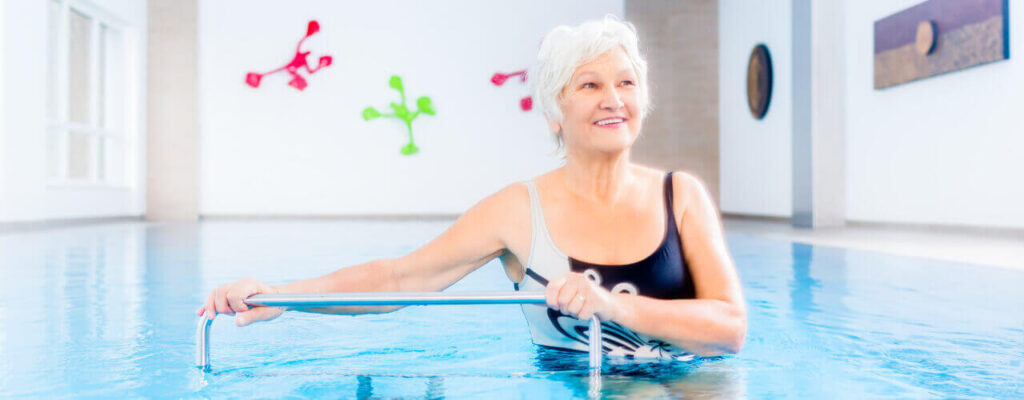Feeling Off-Balance? Aquatic Therapy Can Improve Gait and Stability!

When you’re standing up, do you ever find yourself leaning against a wall or a piece of furniture for support? Have you noticed that the way you walk has changed because of pain in your knees, hips, or other joints? If you nodded as you read those phrases, you may be suffering from a gait or balance condition!
When we are not in the water, gravity has an impact on our balance and gait. There is less weight applying pressure to our main joints during water therapy, which allows for much easier, simpler movement. Water applies a relaxing, supportive pressure to the body, promoting relaxation and a reduction in muscle tension.
Aquatic and vestibular therapy can significantly reduce your symptoms and perhaps correct your gait or balance problem. If you’d like to learn more about how you can start improving your balance and gait condition, call Freedom Rehab Aquatic Therapy and Balance Center in Florida today! In the meantime, keep reading to learn more about balance and gait issues, and how aquatic therapy can help.
Common gait and balance disorders
Gait and balance are two different things, and so are disorders that affect them.
With balance disorders, people report feeling as if they are about to fall, staggering when attempting to walk, as well as a sensation of floating. Blurred vision and feelings of disorientation are also common.
Balance disorders are both physical and mental, as your brain may think you are moving, even when you are not. Changes to your joint strength, mobility, and ability to sense where your joints are in space (proprioception), all have physical consequences on your balance.
A few types of balance disorders are Meniere’s disease, Vestibular Neuronitis, Perilymph Fistula, and Benign Paroxysmal Positional Vertigo (BPPV).
Gait disorders cause abnormal movements in the way you walk and run, and these can become exaggerated with age. The likelihood of developing a gait problem rises with age. Older people are more likely to develop disorders that cause irregular gait and have weaker muscles, slower reactions, and poorer muscle coordination than younger people.
Gait disorders can also be caused by stroke, inner ear problems, foot conditions, or even something as simple as ill-fitting shoes. Propulsive gait, spastic gait, and scissored gait are all common gait disorders that aquatic therapy at Freedom Rehab Aquatic Therapy and Balance Center could help.
How does an aquatic therapist help with gait and balance?
Many different circumstances and underlying reasons might contribute to gait and balance issues. Proprioception, or your overall feeling of location, is aided by the vestibular system.
The vestibular system is a complicated collection of sensory nerves and fluid-filled chambers housed in the inner ear, as well as the hundreds of nerve receptors in your joints, which are linked to many balance disorders. When this system is thrown off, your balance is affected.
Vestibular rehabilitation works to improve your vestibular system as a whole, including your vision, nerves, and muscles, in order to maintain a steady balance. If you are dealing with BPPV, our therapists can help you learn specific exercises that can dislodge and move the loose calcium debris to the correct parts of your ear.
It’s important to get help if you are having trouble remaining steady, as you want to prevent falling and injuring yourself. Aquatic therapy is one of the best options for balance and gait disorders. Our Florida physical therapists can provide you with the best techniques for improving your balance and ability to walk.
Your therapist will do a complete analysis of your balance and gait at your first appointment. From there, they’ll be able to pinpoint what is causing to you have trouble walking or remaining upright.
Your treatment program may involve a variety of stretches. Stretching is one of the easier treatments your physical and occupational therapist might suggest. It helps to improve your range of motion and flexibility, thus giving you more control over your movements. Stretching will also prevent your muscles from becoming too stiff or tight.
Gait retraining exercises can also be performed in the water, as well as strengthening activities like walking from one side of the pool to the other. This is something that requires more effort in the water than it does out of it because water has up to 12 times the resistance of air. Runners can benefit from this kind of therapy technique especially.
Are you ready to get back on your feet?
The best way to find out if aquatic therapy can help you to feel more balanced and confident in your ability to remain independent is to contact us today for an appointment. Our therapists are skilled professionals who know how to diagnose and treat a variety of gait and balance problems, and yours will be no different!
